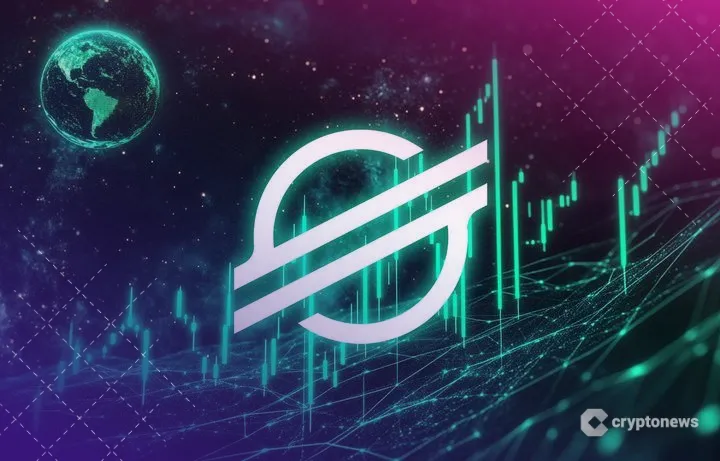Stellar ($XLM) has risen by 5% as major partnerships fueled its push toward mainstream finance. The token now flirts with $0.41, backed by a $12B market cap and real-world adoption momentum.
With big-name integrations and bullish technicals, the blockchain is quietly becoming a highway for global payments, and traders are starting to notice.
$XLM Continues to Power Global Finance with Strategic Partnerships
The Stellar network operates as a decentralized, fast, and scalable blockchain, purpose-built for financial products, remittances, and real-world asset transactions.
Unlike networks that rely on energy-intensive or wealth-concentrated validation models, Stellar is built on a unique Proof-of-Agreement (PoA) consensus known as the Stellar Consensus Protocol (SCP). SCP secures the network through a system of trusted validators, chosen by each node.
While the Total Value Locked (TVL) of $134 billion reflects broader network activity and tokenization beyond just XLM’s DeFi presence, it also shows the substantial economic activity flowing through the Stellar ecosystem.
The network is consistently ranked among the top blockchains for cross-border payments, with multi-currency transaction support built in from the outset. Developers and businesses are empowered to build compliant and cost-effective payment solutions that work globally, regardless of local banking infrastructure.
Stellar’s institutional adoption continues to expand. The network has forged major partnerships with global giants like MoneyGram International, Franklin Templeton, WisdomTree, and PayPal, positioning Stellar as a core partner for tokenizing real-world assets and facilitating institutional remittances and payouts.
For instance, PayPal plans to launch its widely anticipated stablecoin PYUSD on the Stellar network. This integration is expected to onboard millions of users into the Stellar ecosystem, especially for cross-border transactions and Pay-Fi (payment-finance) solutions.
Further expanding its influence, Visa recently announced support for the Stellar and Avalanche networks, incorporating stablecoins like PYUSD, USDG, and EURC into its international payments framework. This partnership cements Stellar’s role as a key backend layer for next-gen fintech.
The Stellar Development Foundation (SDF) continues to drive development through protocol upgrades. The recent release of Stellar Project 23, which coincided with a positive price movement for XLM, showcases this ongoing development.
Additionally, CAP-67, a structured event generation upgrade, along with new features like Retroactive Events, was featured in Stellar’s July newsletter to improve developer tooling and ecosystem transparency.
$XLM/$USDT Builds Rounded Base as Buyers Begin Testing Resistance
The 4-hour chart of $XLM reveals a maturing rounded bottom structure that’s pushing into a short-term breakout area near $0.42. The recent move higher from the $0.36 support zone has developed on gradually increasing volume, a sign of organic accumulation rather than purely short liquidations.
This sets a different tone from the steep parabolic runs seen earlier in July.
The rise in volume over the past few sessions, especially as Stellar’s price approached $0.41, reflects broader participation. That’s an encouraging signs when paired with a clean base formation like this one.
Although the current push is still testing resistance, there are signs of initiative. In the lower time frame volume footprint, we also observed how market participants reacted when the price compresses in a tight range with alternating green and red deltas.
On similar structures, the key is not just whether price breaks higher, but whether aggressive buyers step in to follow through.
For now, $XLM is showing balanced volume behavior, which supports a continuation bias, but not without a confirmation push.
On the momentum front, indicators have turned constructive. RSI has climbed to 56.44, recovering from deeply neutral levels and indicating a mild bullish skew.
There’s no divergence, but the slope is positive, and the RSI has crossed its moving average, which tends to precede extension moves.
MACD also supports this interpretation. The MACD line has crossed above the signal line, while the histogram has flipped green, which indicates that the bullish momentum is picking up for the first time since mid-July.
Both indicators still sit in neutral zones, giving room for further upside.
Key resistance remains just above at $0.425, which aligns with a previous consolidation area before the July drop.
If the price appreciates beyond this level, the next upside target lies near $0.46.
Failure to clear $0.415 would keep $XLM in consolidation, though the rounded base structure would remain valid unless price breaks back below $0.384.
The post $XLM Jumps 5% to $0.41 After PayPal PYUSD and Visa Deals – Is $0.46 Next? appeared first on Cryptonews.

